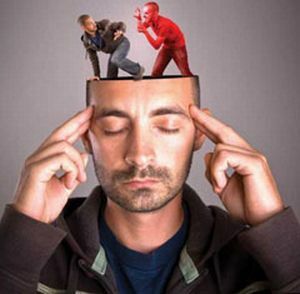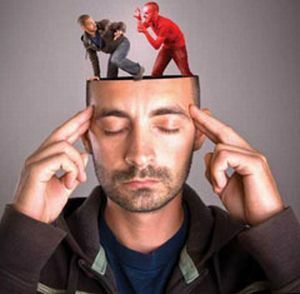The obsessive-compulsive disorder is an obsessive-compulsive syndrome.
This violation of the human psyche means the presence in consciousness of persistent thoughts, ideas, actions. This is a serious enough deviation of the nervous system, which must be long and difficult to treat by consulting a doctor.
Neurosis is often observed in persons with a special mentality and is manifested by self-doubt, doubts, anxiety, suspiciousness.
It is peculiar to people anxious-hypochondriac, timid, extremely conscientious people.
Certain obsessions are observed in almost healthy people.
Contents
- Causes of neurosis
- How does the obsessive-compulsive disorder syndrome
- Obsessive-state syndrome test
- Diagnostic techniques
- Treatment - psychology or therapy?
- Pharmacotherapy
- Cognitive-behavioral treatment
- Stop thought his
- hypnotic state
- Transactional Analysis
- biological method
- Prevention
- Video: Obsessive-compulsive disorder
reasons neurosis
main reason obsessional neurosis is trauma , resulting in conflict situations,created by contradictory actions.
To promote the development of the syndrome may:
- child psychological trauma;
- quarrels in the family;
- negligent attitude towards children;
- increased care;
- impossibility for the child to independently know the world;
- complexes and fears of adults, experiences that are specially or accidentally reflected on the child;
- strong stress;
- constant quarrels with others;
- overwork;
- brain injury;
- brain damage;
- schizophrenia and other mental disorders;
- total body poisoning;
- autoimmune abnormalities.
Obsessive-Compound Syndrome is characterized by involuntary obsessive-compelling doubts, fears, perceptions, memories and actions in a critical attitude towards them and attempts to fight them.
There are three possible forms of leakage:
- the symptoms persist for years;
- remitting flow;
- progressing current.
The characteristic and mandatory symptoms of the obsessive-compulsive disorder syndrome are:
- constantly repeated actions, thoughts, feelings;

- understanding of illogic, unnecessary and painful actions;
- useless attempts to get rid of obsessions on your own.
You can take a test for obsessive-compulsive disorder right now, for this you must have :
- A painful condition does not last a lifetime and is permanent.
- The states are combined with a sense of fear.
- Obsessive states in the form of specific rituals that do not bring long-term satisfaction.
Obsession Syndrome Test Yale-Brown scale was originally developed for use by specialists in the field of the psyche. All 10 test points are filled in when the patient is interviewed, after which the number of points is counted.
Each of the questions is evaluated according to the 5-point principle from 0 to 4.For each item, the average indicator of symptom severity is determined within the last 7 days. Due to the re-application of the scale, an evaluation of the ongoing treatment of the compulsive disorder syndrome is carried out.
The test is also suitable for use as an indicator of self-assessment of the state of the psyche. This version of the scale is used when conducting a large number of patients.
When assessing the patient's condition, the symptom severity is studied by for 5 indicators: duration of symptoms within 24 hours, level of disability, level of moral discomfort, resistance to manifestations and control over them.
Total score calculation:
- 0-7 - latent state;
- 8-15 - disorder of mild degree;
- 16-23 - an average disorder;
- 24-31 - severely violated;
- 32-40-deviation extremely severe.
 Such an incomprehensible and unpleasant vegetative vascular dystonia hypotonic type - how to diagnose and cure the disease.
Such an incomprehensible and unpleasant vegetative vascular dystonia hypotonic type - how to diagnose and cure the disease.
Find out where to begin treatment of brain encephalitis and why timely diagnosis is of paramount importance.
Diagnostic techniques
There are so-called border states of , which are characterized by the simultaneous presence of manifestations of neuroses and severe mental illnesses.
Correctly identify a specific disease can only a professional who knows the clinical picture of the disorder, the personality characteristics of the patient.
Treatment - psychology or therapy?
There are such approaches to the treatment of the neurosis of compulsive states:
- drug;
- psychotherapeutic;
- biological.
Medical treatment
Drug treatment for severe cases is carried out only in a medical institution and is conducted under the supervision of a doctor.
To combat depression in patients at the initial stages of the disease prescribed various drugs against depression( "Fluoxetine", "Clomipramine").
To neutralize the feelings of anxiety use tranquilizers( Clonazepam, Diazepam).
For chronic forms of disorders, psychotropic drugs( Quetiapine) are effective. A combination of drug and cognitive-behavioral therapy is very helpful.
The psychotherapeutic effect on this kind of neurosis also has a positive effect.
The following psychotherapeutic methods of are distinguished:
- cognitive-behavioral treatment;
- way of "stopping the thought";
- psychoanalysis;
- hypnosis;
- transaction analysis.
Cognitive-behavioral treatment
The is the most popular solution when trying to get rid of the obsessive-compulsive disorder syndrome. 
It confronts the patient with his fears, thus prompting to resist. It is this method that is quite effective in treating the disturbance of compulsive movements and rituals.
The main goal of this psychotherapy is to develop a calm type of reaction to persistent thoughts without accompanying them with rituals and deeds. This type of therapy is ideal for treating the neurosis of obsessive conditions in children, because it has no side effects on the body.
Stop thinking your
The way of "stopping the thought" has its nuances with treatment:
- Stage 1 of - selection of a list of unhealthy thoughts and study;
- 2 stage - learn to switch from obsessions to other positive moments in life;
- 3 stage - by means of loud command "stop" and improvised means it is necessary to stop distribution of a state;
- 4 stage - learn to abolish obsessive thoughts through the command "stop" in the mind;
- 5 stage - if a pessimistic image arises, imagine it on the positive side.
Through this method, you can get rid of the deviation of the initial stage yourself. To master the "method of stopping the thought" is quite simple, the main thing is to understand the principle and believe in effectiveness.
The main task of the psychoanalytic method of treating the syndrome is to learn to displace or suppress unnecessary moments in the life of .Since the patient obsessively deviates strongly from events, he must literally step over himself.
This approach is somewhat difficult to treat the disorder, because psychoanalysis requires a patient to bold talk, and with such people it is almost impossible.
Thus, it is often very difficult for specialists to achieve complete liberation from the disorder.
Hypnotic state
 Hypnosis is also quite effective, especially when combined with psychotherapy.
Hypnosis is also quite effective, especially when combined with psychotherapy.
Approximately after 10 sessions of the method, the patient feels relieved from obsessions.
How to defeat the obsessive-compulsive disorder in children with hypnosis?
For the treatment of neurosis in children, is used as an integrated method - hypnosis and suggestion .Children easily contact the doctor, they easily undergo hypnotic treatment.
Transaction analysis
The method enables games, the life scenario and the inner and the patient to defeat the first stage of the disorder, but in most cases this approach is not effective in identifying the chronic forms of deviation.
Transaction analysis is quite difficult to understand. In group sessions, there was progress in the treatment of neurosis in children.
Biological method
Biological method for the treatment of deviation is used by in the most severe disorders and chronic forms of deviation. To neutralize attacks, use strong psychotropic drugs that have an overwhelming effect on the nervous system.
Prevention
Primary prophylaxis:
- anticipating traumatic influences on work and life;
- the proper education of the child;
- prevention of family quarrels;
- warning of repeated manifestation;
- changing attitudes of patients to morally traumatic situations through conversations, auto-suggestion and suggestion;
- increase in brightness in the room, becauselight increases the production of serotonin;
- normal sleep;
- intake of vitamins;
- strengthening of immunity;
- diet with restriction of coffee and alcoholic beverages and including dates, bananas, plums, figs, tomatoes, milk, soy, black chocolate;
- timely and competent treatment of other violations.
Life is arranged in such a way that every minute we can be trapped by psycho-traumatic situations. It is almost impossible to prevent them.
But there is always the ability to quickly get rid of the obsessive state of by visiting a psychologist or psychotherapist. And it depends on the person who is directly responsible for his moral health.
Video: Obsessive-compulsive disorder
The obsessive-compulsive disorder is characterized by the development of obsessive thoughts, memories, movements, thoughts and actions, as well as various pathological fears.




